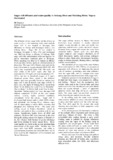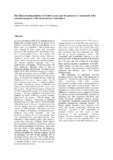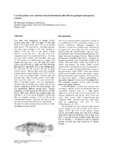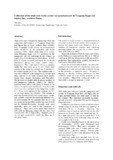Pencarian
Now showing items 1-10 of 32
Domestic effluents and pollution in Imbang River, Negros Occidental
(Bureau of Agricultural Research, Department of Agriculture, 2007)
Domestic effluents, or waste waters from human settlements, were sampled from eight stations along Imbang River in Negros Occidental from July 1993 to February 1995. Three types of domestic waste waters were produced by ...
Adaptation of integrated fish-duck-pig farming system in Leyte
(Bureau of Agricultural Research, Department of Agriculture, 2007)
Adaptation of a fish-duck-pig integrated farming system was conducted at the Busay Freshwater Experimental Farm in Babatngon, Leyte. Genetically improved farmed tilapia (GIFT) and common carp (at a ratio of 4:1) were stocked ...
Changes in the fish diversity and abundance on a heavily fished fringing reef on Santiago Island, Pangasinan, Philippines
(Bureau of Agricultural Research, Department of Agriculture, 2007)
Fish assemblages on the reef slope, reef flat, and seagrass beds on Santiago Island were sampled over 18 months in 1992-1993 as part of a 6-year reef monitoring project started in 1986. Abundance and species diversity were ...
Shrimp pond effluents and water quality in Imbang River, Negros Occidental
(Bureau of Agricultural Research, Department of Agriculture, 2007)
The contribution of shrimp farm effluents to the pollution load in Imbang River, Negros Occidental was measured during the period May 1993 to February 1995. Shrimp pond effluents were characterized and the pollution load ...
Sugar mill effluents and water quality in Imbang River and Malisbog River, Negros Occidental
(Bureau of Agricultural Research, Department of Agriculture, 2007)
The effluents of two sugar mills and the effects on water quality in the receiving rivers were studied. Sugar mill A was located in Barangay Dos Hermanas in Talisay and discharged directly into Imbang River. Sugar Mill B ...
The fish processing industry in Central Luzon and the processors' assessment of the extension program of the Department of Agriculture
(Bureau of Agricultural Research, Department of Agriculture, 2007)
A survey was done in 1992 of 242 fish processors in Region III or Central Luzon: 57 in Bataan, 39 in Bulacan, 24 in Nueva Ecija, 45 in Pampanga, 41 in Tarlac, and 36 in Zambales. The fish processors were engaged in three ...
Use of soybean meal and rice bran in formulated diets for the grouper Epinephelus coioides
(Bureau of Agricultural Research, Department of Agriculture, 2007)
Two diets were formulated to include 8–14% soybean meal and 9–18% rice bran, 34–40% fish meal, 4–5% mussel meal, and 7–8% Acetes shrimp meal, and 11–13% cod liver oil. Soy bean meal and rice bran were included at 4:1 ratio ...
The tuna fishery off northwestern Luzon: catch of purse seines and hand lines operating around fish-aggregating 'payaw'
(Bureau of Agricultural Research, Department of Agriculture, 2007)
The tuna fishery along northwestern Luzon was studied from March 1994 to April 1995. About 120 units of fish aggregating ‘payaw’ were set 20–100 km offshore and fished by about 350 handline boats and 6 purse seines. The ...
Collection of the mud crab Scylla serrata var paramamosain in Tinagong Dagat and Sapian Bay, northern Panay
(Bureau of Agricultural Research, Department of Agriculture, 2007)
Mud crabs were collected by baited traps from the mangroves and estuaries of Tinagong Dagat Bay and Sapian Bay in Capiz, northern Panay monthly over 18 months. Scylla serrata var paramamosain made up 95.4% of the collection ...
Treatment of shrimp pond effluents by sedimentation and by seaweed and mussel biofiltration
(Bureau of Agricultural Research, Department of Agriculture, 2007)
Tiger shrimp Penaeus monodon were stocked in three 1,000 m<sup>2</sup> ponds at 12,000 juveniles/pond and grown for 141 days. Water quality in the ponds was monitored over the grow-out period, particularly before and after ...










